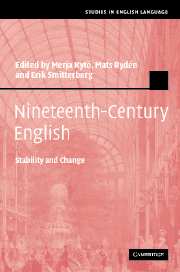Book contents
- Frontmatter
- Contents
- List of plates
- List of figures
- List of tables
- List of contributors
- Acknowledgements
- Introduction: Exploring nineteenth-century English – past and present perspectives
- 1 Modifiers describing women and men in nineteenth-century English
- 2 Words in English Record Office documents of the early 1800s
- 3 The subjunctive in adverbial clauses in nineteenth-century English
- 4 The passive in nineteenth-century scientific writing
- 5 Relativizers in nineteenth-century English
- 6 Anaphoric reference in the nineteenth century: that/those + of constructions
- 7 Adjective comparison in nineteenth-century English
- 8 Nonfinite complement clauses in the nineteenth century: the case of remember
- 9 The in -ing construction in British English, 1800–2000
- 10 Partitive constructions in nineteenth-century English
- Appendix
- References
- Name index
- Subject index
1 - Modifiers describing women and men in nineteenth-century English
Published online by Cambridge University Press: 22 September 2009
- Frontmatter
- Contents
- List of plates
- List of figures
- List of tables
- List of contributors
- Acknowledgements
- Introduction: Exploring nineteenth-century English – past and present perspectives
- 1 Modifiers describing women and men in nineteenth-century English
- 2 Words in English Record Office documents of the early 1800s
- 3 The subjunctive in adverbial clauses in nineteenth-century English
- 4 The passive in nineteenth-century scientific writing
- 5 Relativizers in nineteenth-century English
- 6 Anaphoric reference in the nineteenth century: that/those + of constructions
- 7 Adjective comparison in nineteenth-century English
- 8 Nonfinite complement clauses in the nineteenth century: the case of remember
- 9 The in -ing construction in British English, 1800–2000
- 10 Partitive constructions in nineteenth-century English
- Appendix
- References
- Name index
- Subject index
Summary
Introduction
The investigation presented here concerns modifying expressions used in descriptions of real or fictional women and men by nineteenth-century female and male writers. The aim is to study whether, in these descriptions, the social changes that occurred during the century, especially in the role of women, are reflected in linguistic change, and if so, to what extent. The expressions under investigation are modifiers such as good-natured, sallow, troublesome and of fortune, and they will be studied from a qualitative as well as a quantitative perspective.
During the nineteenth century, the notion that women and men belonged to separate spheres of society very much influenced the way gender roles were formed. This notion had its roots in eighteenth-century economic, social and political conditions, and practically every aspect of life was influenced by it (Kingsley Kent 1999: 154). Powerful and respectable men operated in the public sphere of work and politics; virtuous and dependent women reigned over the domestic sphere, ‘where their authority over all matters pertaining to morality and civility went uncontested’ (Kingsley Kent 1999: 147).
During the century, however, women challenged this notion of separate spheres. The women's movement developed and women demanded certain civil rights, access to education and, the most radical demand of all, the right to vote (Kingsley Kent 1999: 191–3; see also section 4.7 below). In 1869, Girton, the first college for women was founded and by and by, what Kingsley Kent (1999: 229) terms ‘new women’ were admitted to colleges and universities.
- Type
- Chapter
- Information
- Nineteenth-Century EnglishStability and Change, pp. 17 - 55Publisher: Cambridge University PressPrint publication year: 2006
- 4
- Cited by

